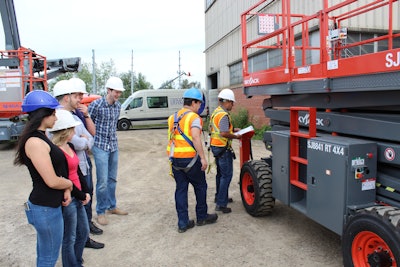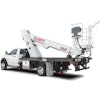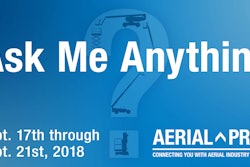
If a Mobile Elevating Work Platform (MEWP) operator has been trained, is there ever a need for that operator to undergo training again? Before you answer the question, consider if you had to reapply for your driver’s license tomorrow, could you pass the test? How much have you forgotten from courses you have taken in the past?
MEWP operator training is not simply the knowledge of how to make the machine move. A qualified MEWP operator must know the requirements for application, inspection, training, maintenance, repair and safe operation of the equipment, while the capabilities and recommended safety guidance and standards are changing and being updated all the time.
Consider the fact that a MEWP operator is required to maintain the appropriate minimum approach distance (MAD) from energized power lines, yet 50% of persons electrocuted during MEWP operations are in contact with a power source. They obviously knew how to make the equipment move, yet they did not meet the requirements for safe operation.
The current ANSI standard require retraining based on the user’s observation and evaluation of the operator. Further, it requires the user to monitor their performance and supervise their work to ensure the use, application, and operation of the aerial platform is in conformance with the provisions set forth in the standard.
So what is retraining? The new ANSI standard defines retraining as the required instruction based on the user's observations or evaluations to maintain a previously trained person's status as a qualified operator. The CSA B354.8 training standard states that “retraining might require complete theory and practical training or partial refresher training based on the evaluation of the operator”.
The new ANSI standards require that the operator's evaluation can be accomplished through visual observation at a minimum, and shall be documented for retention by the user. Additionally, the new standard defines examples of situations when retraining “would be” necessary (”might be” in the Canadian standard). These include:
a) Expiration of the operator's valid training period
b) Deterioration of the operator's performance
c) The operator's extended period of time with no operation of a MEWP
d) The operator's introduction to new or significantly different MEWP technology
e) The operator has been involved in an accident or near miss with the MEWP
In addition, the new MEWP training standard (A92.24) offers several informative appendices for documentation of knowledge and practical (hands-on) evaluation sheets. While the annexes are not mandatory, they do provide a level of detail that should not be ignored in any documentation.
So, while the new training standard identifies all of the requirements for operator training and familiarization, that knowledge must be maintained to ensure the person is qualified to safely and efficiently operate the MEWP prior to authorization to operate. This requires ongoing evaluations and retraining as necessary.
![Tony Groat Edited 5b57430ec070e[1] Headshot](https://img.forconstructionpros.com/files/base/acbm/fcp/image/2024/06/Tony_Groat_edited.5b57430ec070e_1_.667c30792412c.png?auto=format%2Ccompress&crop=faces&fit=crop&h=48&q=70&w=48)




















